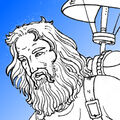Template:Selected anniversaries/April 15: Difference between revisions
No edit summary |
No edit summary |
||
| Line 71: | Line 71: | ||
||Thomas Brooke Benjamin (b. 15 April 1929) was an English mathematical physicist and mathematician, best known for his work in mathematical analysis and fluid mechanics, especially in applications of nonlinear differential equations. Pic. | ||Thomas Brooke Benjamin (b. 15 April 1929) was an English mathematical physicist and mathematician, best known for his work in mathematical analysis and fluid mechanics, especially in applications of nonlinear differential equations. Pic. | ||
| | ||1952: Alexander Crichton Mitchell dies ... physicist with a special interest in geomagnetics who worked for many years in India as a professor and head of a meteorological observatory before returning to Scotland. He then worked with the Royal Navy to devise a system, known as an anti-submarine indicator loop, for detecting submarines by detecting currents induced in a loop of wire on the sea floor. Pic: http://indicatorloops.com/mitchell.htm | ||
File:Edward Lorenz.jpg|link=Edward Lorenz (nonfiction)|1983: Mathematician and alleged time-traveller [[Edward Lorenz (nonfiction)|Edward Lorenz]] publishes new class of [[Gnomon algorithm]] functions which use the butterfly effect to detect and prevent [[crimes against mathematical constants]]. | File:Edward Lorenz.jpg|link=Edward Lorenz (nonfiction)|1983: Mathematician and alleged time-traveller [[Edward Lorenz (nonfiction)|Edward Lorenz]] publishes new class of [[Gnomon algorithm]] functions which use the butterfly effect to detect and prevent [[crimes against mathematical constants]]. | ||
||Grete (Henry-)Hermann | ||1984: Grete (Henry-)Hermann dies ... mathematician and philosopher noted for her work in mathematics, physics, philosophy and education. She is noted for her early philosophical work on the foundations of quantum mechanics, and is now known most of all for an early, but long-ignored refutation of a no-hidden-variable theorem by John von Neumann. Pic. | ||
||Hans Maass | ||1992: Hans Maass dies ... mathematician who introduced Maass wave forms (Maass 1949) and Koecher–Maass series (Maass 1950) and Maass–Selberg relations and who proved most of the Saito–Kurokawa conjecture. | ||
||1993 | ||1993: John Tuzo Wilson dies ... geophysicist and geologist. | ||
||2009 | ||2009: László Tisza dies ... physicist and academic (b. 1907) | ||
||2013 | ||2013: Benjamin Fain dies ... physicist and academic (b. 1930) | ||
||2014 | ||2014: John Houbolt dies ... engineer and academic (b. 1919) lunar | ||
File:Cantor Parabola.jpg|link=Cantor Parabola|2017: Math photographer [[Cantor Parabola]] attends Minicon 52, taking a series of photographs with temporal superimpositions from Minicons 51 and 53. | File:Cantor Parabola.jpg|link=Cantor Parabola|2017: Math photographer [[Cantor Parabola]] attends Minicon 52, taking a series of photographs with temporal superimpositions from Minicons 51 and 53. | ||
Revision as of 10:24, 29 August 2018
1452: Polymath Leonardo da Vinci born. His areas of interest will include painting, sculpting, architecture, invention, science, music, mathematics, engineering, literature, anatomy, geology, astronomy, botany, writing, history, and cartography.
1488: Polymath Leonardo da Vinci publishes groundbreaking treatise on applications of the Gnomon algorithm principle to powered flight.
1707: Mathematician and physicist Leonhard Euler born. He will make important and influential discoveries in many branches of mathematics, and will introduce much of the modern mathematical terminology and notation, such as the notion of a mathematical function.
1764: Astronomer and mathematician Peder Horrebow dies. he invent a way to determine a place's latitude from the stars.

1854: Scientist and inventor Johann Philipp Reis uses scrying engine technology to fight crimes against mathematical constants.
1878: Physicist Ernst Ruhmer born. He will invent applications for the light-sensitivity properties of selenium, including wireless telephony using line-of-sight optical transmissions, sound-on-film audio recording, and television transmissions over wires.
1911: Physicist Johannes Bosscha Jr. dies. He made important investigations on galvanic polarization and the rapidity of sound waves; he was one of the first (1855) to suggest the possibility of sending two messages simultaneously over the same wire.
1925: Chemist, X-ray crystallographer, and crime-fighter Rosalind Franklin publishes Gnomon algorithm model which anticipates the use of DNA (deoxyribonucleic acid) to detect and prevent crimes against chemistry.
1926: Aviator Charles Lindbergh opens service on the newly designated 278-mile (447 km) Contract Air Mail Route #2 (CAM-2) to provide service between St. Louis and Chicago (Maywood Field) with two intermediate stops in Springfield and Peoria, Illinois.
1983: Mathematician and alleged time-traveller Edward Lorenz publishes new class of Gnomon algorithm functions which use the butterfly effect to detect and prevent crimes against mathematical constants.
2017: Math photographer Cantor Parabola attends Minicon 52, taking a series of photographs with temporal superimpositions from Minicons 51 and 53.
2019: Steganographic analysis of Two Creatures 2 unexpectedly reveals "at least fifty megabytes" of encrypted data.











